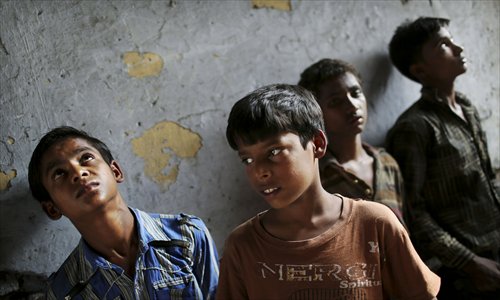Slavery still alive in India

Indian bonded child laborers wait to be taken away after being rescued during a raid by workers from the Save the Childhood Movement, at a garment factory in New Delhi, India on June 12, 2012. Photo: IC
Slavery is still alive and well in India. The country is estimated to have several million modern day slaves thanks to its structured caste system, which can be taken advantage of by the powerful and the dominant.
Professor Bernardo A. Michael from Messiah College, Pennsylvania, US who teaches South Asian history told the Global Times, "Caste continues to remain a key ingredient in the emergence of new social patterns in India. It continues to be a source of inequality and exploitation."
The latest Global Slavery Index (GSI) report published by Melbourne's Walk Free Foundation on October 17 points out that the largest estimated number of people trapped in modern slavery are in India. The figure hovers between 13.3 million and 14.7 million people in enslavement.
The largest proportion of this problem is the exploitation of Indian citizens within India itself, particularly through debt bondage and bonded labor, according to the GSI report.
Subtle slavery
This is certainly the case for millions of bonded and forced laborers in the South-Asian countries of India, Pakistan and Nepal, the vast majority of whom are Dalits, of "low" caste status, indigenous people or other minority groups.
The International Labor Organization (ILO) states that there are 20.9 million men, women and children around the world who are enslaved. What is painful to see in the 21st century is that people are still sold like objects, forced to work for little or no pay and at the complete mercy of their "employers."
"We were enslaved after being lured with a show of currency and were forced to work on the fields for a prolonged time without proper food. The land-owner had completely stopped us from visiting my children once I was trapped here," Geeta, a 45-year-old laborer who has been forced to work in a field near Delhi, told the Global Times.
The system of bonded labor is just another word for slavery. Bonded labor is the most widely used method of enslaving people around the world.
Anti-Slavery International, an organization that works to eliminate all forms of slavery, said "Bonded labor is the most widely used method of enslaving people around the world. A person becomes a bonded laborer when their labor is demanded as a means of repayment for a loan. The person is then tricked or trapped into working for very little or no pay, often for seven days a week. The value of their work becomes invariably greater than the original sum of money borrowed. Often the debts are passed on to the next generation."
M.K. George, director of the Indian Social Institute, a human rights based organization, comments, "I guess slavery in the strictest sense of the word does not exist here. But we have evolved very subtle and smart modern slavery: Domestic workers, particularly the live-in workers, for instance. They are subjected even to physical and sexual abuse."
Rooted in discrimination
Anthropologist Kiran Kamal Prasad, who has fought bonded labor in India for several decades, says the problem is linked to the caste system. In India, it is not just an economic issue, but it has a very important social dimension; it is part of the caste system.
The caste system is itself based, to a great extent, on exploiting the labor of Dalits. The struggle against bonded labor thus strengthens the efforts to abolish the caste system, as an effective fight against the caste system must involve a fight against bonded labor. Since most bonded laborers are Dalits and Adivasis in India, working against bonded labor means working for the most marginalized sections of society.
"It seems that 86 percent of these Dalits in India are landless or have minuscule patches of land which invariably leaves them economically dependent on their employers who in turn use this as an opportunity to exploit. These laborers are then dished out extremely poor wages or in some cases nothing at all and are subject to violence, social and economic boycotts,'' says Jose Kavi, CEO of Matters India (a labor-focused media forum) told the Global Times.
Kavi explains that although laws in India, Pakistan and Nepal prohibit such labor, millions of unfortunates continue to be enslaved. As Anti-Slavery International says, it is because the discrimination that underpins the system of bonded labor also helps in perpetuating it.
It has been observed that lower-level bureaucracies are reluctant to implement legislation that prohibits bonded labor as they fear a backlash from the local landlords and contractors. These individuals and even institutions themselves could be inherently discriminatory and sympathize with the belief that minority groups owe a duty of labor to landlords for little pay.
All pervasive evil
It is illustrated by the fact that even 37 years since the Bonded Labor System (Abolition) Act was passed, 2.6 million bonded laborers were identified by a Gandhi Peace Foundation study earlier this year.
Meanwhile the figure arrived at by the ILO at the same time was 11.7 million, which is much higher.
The system of slavery has slowly morphed into an all pervasive evil that exists in every nook and cranny of the social fabric. It is no longer limited to the traditional power equation in agriculture, in which the lower castes are expected to perform menial tasks in exchange for guaranteed subsistence, but is found in all sectors.
Poor and without resources, people take credit from the local landlord or factory owner or contractor fall into the pattern of debt bondage. The loan is akin to an advance on wages, to be paid off by working. Except it would seem the debt is never repaid and only keeps growing. Piling interest, charges for delayed payments, meager wages, and fresh loans for subsistence and emergencies means there is no escaping bondage.